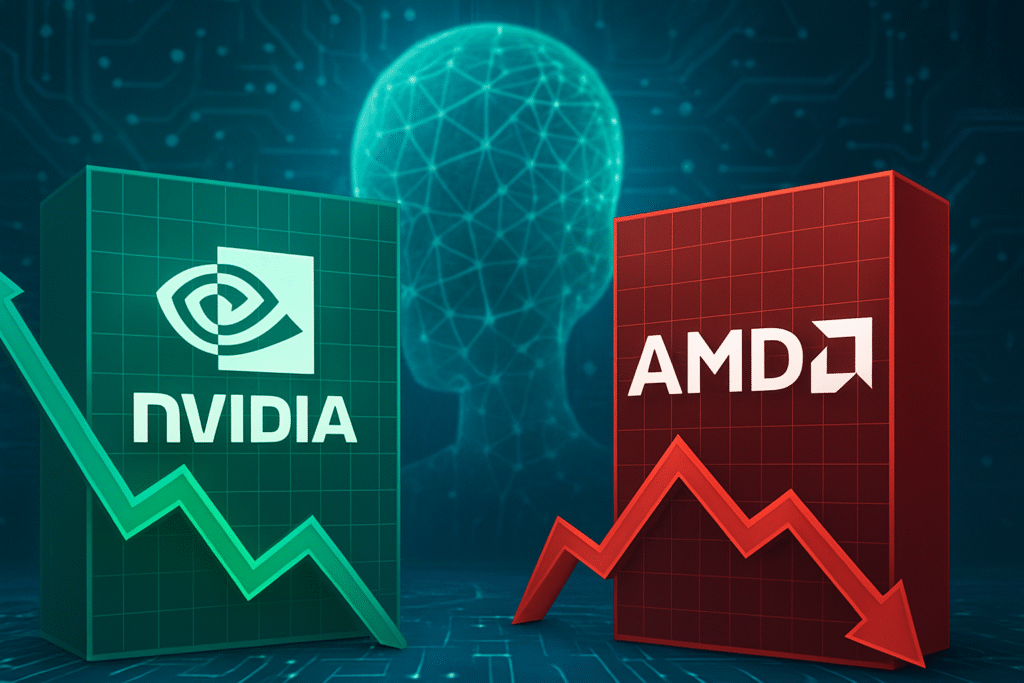Nvidia’s share price jitters and AMD’s recent momentum have everyone asking the same thing is this another routine rotation, or a signal that the center of gravity in AI hardware is shifting?
Within the first trading minutes after any headline, flows can swing fast but the deeper story is about supply, software ecosystems, and customer roadmaps that quietly set the next six to twelve months for AI chip stocks.
why volatility keeps visiting AI chip stocks
Short term moves often say more about positioning than fundamentals. After a year of breathtaking gains, profit taking kicks in whenever sentiment cools even a little. Options dealers hedge, momentum funds rebalance, and passive inflows pause. Meanwhile, hyperscalers keep spending.
The result prices wobble while underlying demand for GPU class compute stays firm. That’s why day to day stress shouldn’t distract from the real levers capacity, performance per dollar, and developer lock in.
The question isn’t only who makes the fastest chip, but who can deliver compute on time, at scale, with predictable software performance? Sustained pricing power comes from that trifecta.
When supply is tight, customers pay up for delivery guarantees when new capacity lands, buyers get choosier and press vendors on total cost of ownership (TCO).
Fundamentals diverge: roadmaps, software moats, and supply
Nvidia’s edge is still its end to end stack CUDA, libraries, networking, and a developer base built over a decade. That software moat compresses time to value for enterprise AI teams. AMD, meanwhile, is translating architectural gains into competitive accelerators and improving its ROCm software stack.
As ROCm matures and model frameworks optimize for it, the performance gap narrows in many workloads, especially training at scale and transformer inference.
Capacity is the swing factor. If HBM supply (high bandwidth memory) and advanced packaging stay tight, any vendor who can ship on schedule gets rewarded. As more HBM lines come online, procurement chiefs diversify to reduce single vendor risk an underappreciated tailwind for challengers.
how big buyers actually choose
One North American cloud giant standardized its flagship AI clusters on Nvidia to accelerate time to market, then spun up a parallel track with AMD accelerators for internal inference services where software porting costs were manageable. Outcome blended TCO dropped, and procurement gained leverage in future negotiations.
A global bank piloted AMD for risk model backtesting where they could containerize workloads with minimal CUDA dependencies. For quant research still tied to CUDA first tools, they stayed Nvidia. Outcome they freed premium GPUs for frontier models and used AMD where portability was easy.
An AI video company rented Nvidia instances for training while moving inference to AMD backed clouds once their pipelines stabilized. Outcome lower unit economics without sacrificing quality proof that mixed fleets can work when DevOps is disciplined.
These examples underscore a pattern: buyers optimize workload by workload, not vendor by vendor. That granular thinking is good for long run adoption across the sector and supportive for AI chip stocks broadly.
what pros are watching
HBM availability and node transitions. Analysts emphasize that HBM capacity unlocks accelerator shipments watch lead times as the cleanest demand proxy.
Ecosystem gravity. The wider the software library support (compilers, graph optimizers, inference runtimes), the stickier the platform. CUDA remains the incumbent, but ROCm’s steady improvements are narrowing the soft moat for specific tasks.
Networking and system design. NVLink, PCIe, Ethernet, and Infiniband choices increasingly decide real world throughput. Pros focus on cluster level performance, not only TFLOPs on a spec sheet.
Inference economics. Training wins headlines; inference pays the bills. Vendors that lower latency per dollar at scale will capture enterprise budgets in 2025.
A retail investor perspective: how to think like a buyer
Rather than chasing every tape print, map the buying center: CTOs, procurement, and ML leads. Their constraints data gravity, retraining cadence, uptime SLAs, and cost per token explain order patterns better than any chart. For research, read vendor release notes and framework changelogs.
If PyTorch, JAX, TensorRT, ONNX Runtime, or ROCm get meaningful updates for a workload you follow e.g diffusion or RAG that’s a tell for near term adoption shifts. Build a simple cluster scorecard availability, price, ecosystem, support and update it quarterly.
Software portability: If containerized AI stacks (with Triton/ONNX/TVM) keep improving, the penalty for switching hardware drops. That favors a more competitive landscape and supports multi vendor fleets.
Specialized silicon: NPUs and domain specific chips for inference could siphon workloads from general purpose GPUs, especially in edge and low latency applications.
Power and cooling constraints: Data centers are hitting power ceilings. Vendors that deliver more tokens per watt and integrate liquid cooling at scale will win bids irrespective of brand loyalty.
Total platform economics: The winner’s circle is shifting from fastest chip to cheapest reliable token. Expect more buyers to demand transparent TCO, including networking and software support costs.
Risk check: what could go wrong
A sharp slowdown in AI spending, delays in next gen parts, or a software bottleneck (e.g., framework incompatibility) could hit shipments. On the flip side, surprise breakthroughs in inference efficiency or model compression can unlock demand faster than supply can scale, favoring whoever has inventory ready.
Day to day volatility aside, the structural demand for large scale compute remains intact. Nvidia’s moat in software and systems keeps it central AMD’s execution on accelerators and ROCm is opening genuine alternatives.
For investors, the practical lens is procurement reality timelines, TCO, and portability because that’s what converts hype into orders. In that world, diversified exposure within AI chip stocks can track the secular growth story while respecting competitive churn.

